Zinnia (zinnia): description, planting and care
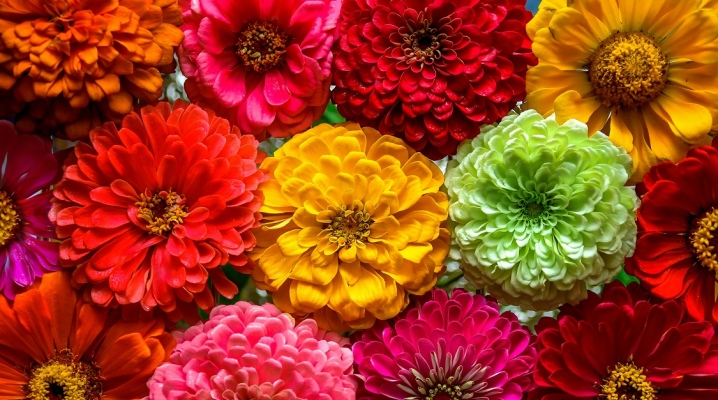
Zinnia is a striking decoration of many modern gardens. This flower has colorful large buds and is completely picky to care for. In this material you will get acquainted with the description of zinnia, and also learn the basic subtleties of planting and caring for this plant.


Peculiarities
Zinnia, or zinnia, is an annual and perennial flowering plant of the subshrub type from the Aster family. Under natural conditions, the flower grows in Central and North America, where it prefers sunny, warm and open areas with well-drained and vitamin-rich soil. The key features of zinnia are low frost resistance, extremely generative reproduction and high moisture consumption.

External features of zinnia:
- height - from 0.3 to 0.9 meters;
- inflorescences in the form of single multi-flowered buds up to 14 cm in diameter on long and thick shoots;
- leaves - ovoid with a hard down, pointed, located in whorls opposite each other;
- densely spaced ligulate flowers with a bright color from snow-white to lilac and burgundy flowers, tubular flowers are small, most often yellow or brown;
- the fruit is a standard achene;
- receptacle - conical and cylindrical.


The flowering period of most zinnia varieties lasts about 50-55 days and, as a rule, begins in mid-June, and ends with the onset of the first cold weather.
The main positive qualities of zinnia:
- a variety of color palette - buds can be of a variety of colors from peach to purple;
- zinnia inflorescences do not fade in direct sunlight, they look great both on a flower bed and in the form of a colorful bouquet;
- this horticultural crop does not require specific maintenance, has excellent health and is tolerant of drought and infertile soil types;
- there are a huge number of varieties and species of zinnia, among which you can find terry, perennial, low and high-growing plants.



Today, zinnias are grown exclusively for decorative purposes - their bright buds can often be seen in the design of garden plots, city yards, balconies and loggias.
Reference! Some gardeners confuse zinnia flowers with gerbera - all due to the fact that these two flowers belong to the same family and are similar in appearance. Key differences between gerbera and zinnia:
- gerbera stalks usually do not grow taller than 60 cm, while zinnia can grow up to 1 meter;
- in zinnia, the petals are usually frequent and rounded, while in gerbera they are less often reed-shaped;
- zinnias bloom for about 55 days, while gerberas bloom for 3 to 4 months;
- in their natural habitat, zinnias grow in Central America, but gerberas were brought to Russia directly from Africa.

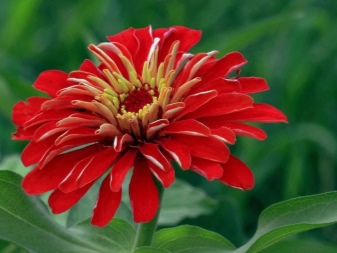
Types and varieties
There are about 20 independent varieties of zinnia in the world, however in horticulture, only about 10 species and varieties of this garden crop are actively grown.
- Graceful. Annual, which is characterized by dense petals with large flower caps up to 17 cm in diameter. The flowering period is from June to September. Includes both short and tall varieties. The color of the petals is varied: from snow-white to lemon and purple.The species is subdivided into independent subspecies and varieties: dahlia (the most popular variety is Polar Bear), cactus (Senorita), chrysanthemum, pompom, as well as Fantasy and Queen red lime.



- Narrow-leaved. Medium-sized plants up to 60 cm high with small double flower caps up to 4 cm in diameter. The petals themselves are tubular and monochromatic - from lemon to dark orange and red.
Includes the following varieties: "Persian Carpet", "Candy Stripe", "Cherry".
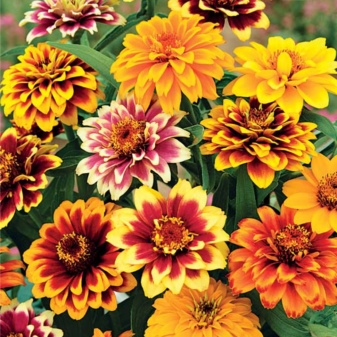

- Hybrid species. This group includes all hybrid varieties of zinnia. Among the most popular varieties and mixtures are the following: Profusion Mixed, Carousel, Swizzle, Shaggy Dog, Magellan, Pepermint Stick, Envy and Double Zhara Raspberry Ripple.
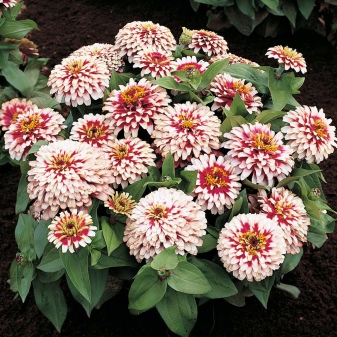

- Fine-flowered. Zinnias of this species look very similar to cosme flowers. They are characterized by loose bushes of medium height with thin peduncles, sparse petals and small flowers up to 3 cm in diameter.


- Linearis. Low-growing perennials and annuals, which are characterized by dense yellow petals and spherical growth of green shoots. The names of popular varieties: Golden Eye, Caramel, Yellow Star.


Among the common mixtures of zinnia, one can single out the "Profusion Double".


How to plant?
The process of planting zinnia in the garden or at home will not seem difficult for experienced flower growers, but there are also subtleties and nuances that you need to pay attention to.
Optimal timing
For many flowering horticultural crops, it is not the growing conditions that are very important, but the time of planting seeds in open ground. The timing of the flowering of the flower, as well as the number and saturation of the buds, depend on this. If we talk about planting zinnia seeds in open ground, then it is usually carried out after cold nights with frosts, which occur in the last days of March or in the first half of April. In the northern regions, these periods are postponed closer to the summer months - until stable warm weather is established without sudden temperature changes.


Seed preparation
Before planting zinnia seeds in open ground or in planting containers, they must be properly prepared.
The seed is wrapped in a cloth moistened with the Epin biostimulator. Thanks to this simple technique, you can determine which zinnia seeds will sprout and which will not. Healthy seeds suitable for planting should sprout on the second day.


Basic landing rules
Below we will consider the features of planting seeds and seedlings of zinnia in open ground.
Planting seeds for seedlings
The seeds that have hatched can be sown in the last days of March in separate cups pre-filled with light and fertile soil, or peat pots. It is advised to plant no more than 3 zinnia seeds in one container - they are buried no deeper than 1 cm into the ground. The seed containers are kept in a cool, draft-free room, well ventilated, and watered regularly. The first shoots should appear in 1-1.5 weeks if all planting conditions are met.
After 5-6 full-fledged leaves appear in the sprouts, daily hardening is carried out, which is designed to adapt the seedlings to external temperature conditions.


Planting seeds in open ground
Zinnia seeds are usually planted in a flower bed in the first half of May. On the landing site, pits are formed with a depth of no more than 4-5 cm.The distance between the holes is 10 cm. One hole fits from 1 to 3 zinnia seeds, which are then sprinkled with fertile soil and watered abundantly. The first shoots should appear in about 7-9 days. When most of the sprouts sprout, the beds are thinned out in such a way that a distance of at least 15-20 cm is observed between the seedlings.If all planting conditions are met, the first buds will appear on the zinnia by July.


Planting young seedlings in a permanent place
Gardeners who prefer to plant ready-made zinnia seedlings in their garden usually choose the second half of May for planting. When planting seedlings, all standard growth conditions for horticultural crops must be observed - it should be a well-lit area without stagnation of moisture and sharp gusts of wind, with air-conductive and neutral soil. In order for the seedlings to better take root in the flower bed, the site is dug up in advance, watered abundantly and fertilized with compost or manure.
Zinnia seedlings do not tolerate picking well, and therefore, during planting of seedlings to a permanent place in open ground, the transshipment method is used - transplanting together with an earthen lump.


How to take care of it properly?
Zinnia is absolutely picky about leaving - this is one of the hardiest garden crops that can successfully grow on a site even without human help. Caring for zinnia bushes includes regular watering, feeding, pinching and preparing the plant for winter - each of these processes should be considered in more detail.
Watering
In order for zinnia to delight you with abundant flowering for a long time, this flower needs not only abundant, but also regular watering. The gardener must constantly ensure that the soil in the near-stem circle near the flower does not dry out and does not form a hard crust. Zinnia also has a negative attitude to excess moisture, and therefore, when watering, it is necessary to take into account the external climatic conditions and the frequency of natural precipitation.
The main rule when watering zinnia is to prevent the ingress of water from the watering can on green shoots and peduncles. This will inevitably lead to rotting and the appearance of fungal diseases.

Under standard conditions, watering of zinnia is carried out no more than 3 times a month, while the settled water of summer temperature is used. Zinnia should be watered in the evening or early morning so that the sun's rays cannot provoke burns on the wet shoots of the flower.
So that the water is better absorbed into the soil and reaches the roots faster, the soil in the near-trunk circle near the zinnia looses - it will also remove nearby weeds. To keep moisture near the roots of the flower for a longer period, a layer of mulch of straw, needles, peat, rotted manure or sawdust should be placed near the stem of the flower.


Top dressing
Experienced gardeners recommend feeding zinnia no more than 2 times per season. The first feeding is carried out during the period of active growth or a month after planting seedlings in open ground. The second is usually introduced into the soil at the beginning of the flowering period or from the beginning of the formation of the first buds. This is necessary to give the inflorescences a rich color and extend the flowering period.
Usually, to fertilize 1 square meter of a flower bed where zinnia grows, you need no more than 15-20 grams of mineral fertilizer diluted in a 10-liter bucket of water. Zinnia is also good for organic fertilizers, but they should not be fresh. - This is especially true for fresh manure, which can simply burn the flower shoots.


The simplest fertilization scheme for adult zinnia bushes as follows:
- during the first feeding during the period of active growth, a solution of urea (15 grams) and fertilizer "Flower" (no more than 30 grams) are mixed with water in a 10-liter bucket;
- the second feeding should be even more nutritious, since it is introduced during the period of inflorescence formation - here no more than 15 grams of "Rainbow" are added to a bucket of water and the same amount of "Agricola" is for flowering garden plants. Alternatively, you can use the drug "Bud".

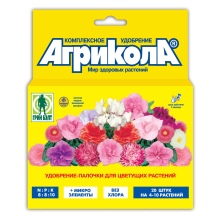

To make the fertilizers better assimilated, before feeding, the soil in the near-stem circle near the flower is fertilized with wood ash - no more than 40 grams per 1 square meter.
Zinnia is best of all related to complex mineral fertilizers., which enter the soil along with irrigation water and contain phosphorus, potassium and calcium.With fertilizers that contain nitrogen, you need to be very careful - they can lead to an increase in shoots and a decrease in the number of buds, in addition, they provoke the appearance of root rot.
Top dressing is needed not only for adult zinnia bushes, but also for young seedlings that are grown for seedlings.
Before the seedlings are planted in the ground or dived to a permanent place, they should be fertilized at least 3 times with mineral fertilizers or rotted manure.

Seed collection
Usually, zinnia seeds are harvested 2 months after the first buds appear on the flower. The seed basket or fruit looks like a small cone with a fluff, which is cut off after drying and yellowing. Gardeners advise to cut only fruit baskets of the most even, beautiful and vibrant flowers.
Cut zinnia baskets are left to dry additionally in a warm and well-ventilated room until the baskets begin to crumble in the hands. After that, the capsules are simply rubbed with your fingers until the zinnia seeds appear.


Before you pack the seeds into different bags or paper bags, it is advised to sort them into separate groups. The fact is that from one seed basket you can get seeds of different bushes - it depends on the degree of readiness of the seeds for planting.
In the seed capsule of zinnia, you can find brown heart-shaped seeds, spear-shaped seeds with a sharp end or elongated ones with a gray tip. The former should be thrown away, as low and faded flowers grow from them, but the latter can be safely planted.
To better preserve the seeds before planting in open ground or in containers, they are placed in paper bags and stored at room conditions.

Pinching
When growing garden and ornamental varieties of zinnia, these plants undergo mandatory pinching or pruning - it is needed to form lateral shoots of the plant. Pinching involves removing the top of the main stem using a disinfected pruning shears or secateurs.
Pinching can be carried out already during the cultivation of seedlings - after the seedlings have 5-6 independent leaves. However, this procedure is best tolerated by already relatively adult bushes of zinnia, which have been growing in open ground for more than a month. You need to cut off at the level of thirds from the top of the sheet plate.
If we are talking about bouquet varieties of zinnia, then they usually do not pinch - here one strong main stem is left, on which a lush bud is located.


Wintering
There are both annual and perennial varieties of zinnia. Perennials growing in the southern regions are pruned and covered with spruce branches for the winter months - this will save them from frost in snowless winters.
If perennial zinnias are grown in the northern regions, then such flowers are best dug out together with an earthen clod and stored in pots at home in winter. When stored in an apartment, zinnia may not stop flowering - for this, already dried flower stalks break off, which stimulates the appearance of new buds.
Further care of the plant is no different from standard outdoor care procedures.


Reproduction methods
Regardless of the variety, zinnia reproduces exclusively by the generative method - that is using seeds... This method is described in detail above. Seed planting can be carried out both directly into open ground (in the case of growing in the southern regions), and in separate containers for seedlings (in northern latitudes such as Siberia and the Urals). If the outside temperature in a garden plot with zinnia seeds drops below zero Celsius, then the planting material will die with almost 100 percent probability.
Reproduction methods such as grafting and dividing the bush, in the case of zinnia, they are used extremely rarely - cuttings and cuttings of this flower take a long time to take root in a new place and in most cases die.
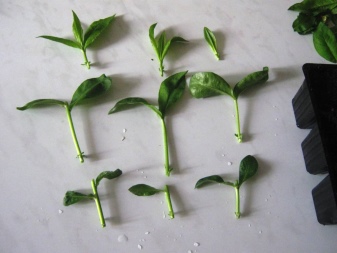

Diseases and pests
The most common pests of zinnia can be considered slugs, aphids and common garden snails, but sometimes the plant is also affected by May beetles. You can get rid of snails and slugs manually, or install several containers of beer near the flower bed, onto which all gastropods usually slide. Then they can be quickly removed. Like slugs, May beetles are also removed from the plant by hand.
It will be more difficult to get rid of common aphids. - usually these insects settle at the bottom of zinnia shoots, where they form whole colonies. The best remedy for aphids is to treat the zinnium with a solution of tar soap and water (100 grams per 100 liter bucket of water). As an alternative, Actellik and Fufanon preparations are suitable. Many gardeners recommend treating aphid-infested horticultural crops with warm water, but this is not recommended for zinnias.


Zinnia is resistant to many viral and fungal diseases, however, if growing conditions are not followed, it can get sick with fusarium, spotting, gray mold or powdery mildew.
The most dangerous diseases for zinnia are powdery mildew and bacterial blight. The first can be recognized by the characteristic white bloom on the shoots of the flower, but the spotting is expressed in the appearance of characteristic gray or brown spots on the leaves of zinnia, which gradually affect the entire leaf.
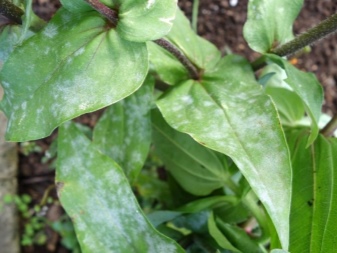

If fungicides such as Fundazola, Skor, Topaz and Topsin will help the plant from gray rot, powdery mildew and fusarium, then spotting cannot be treated - the bushes affected by this disease are immediately isolated from the rest of the flower bed, dug out and destroyed.
The most common reason why zinnia flower arrangements dry up or get sick is banal violation of growing conditions... The main reasons: excess moisture, lack of sunlight, planting on already infected soil, as well as too dense planting of seedlings.

If we talk about the treatment of zinnias, then it is best to banish the appearance of these diseases - for this it will not be superfluous to carry out preventive spraying of the flower with fungicides and simply inspect the seedlings at each watering.
Use in landscape design
Decorating gardens and yards with vibrant colors such as zinnias is considered very popular today. This horticultural crop is usually grown in groups as a mixture of several varieties with different flower colors - this allows you to create accent, rich flower beds and borders.
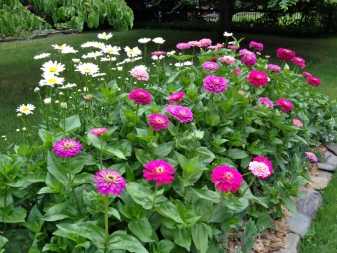
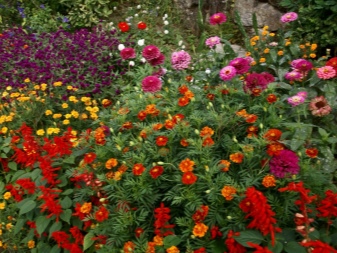
In the design of landscape design, both low-growing and tall varieties of zinnias are used. The latter are usually grown precisely on flower beds or are used to mask unsightly buildings, but undersized ones are planted in decorative pots, serve to decorate garden paths or balconies.

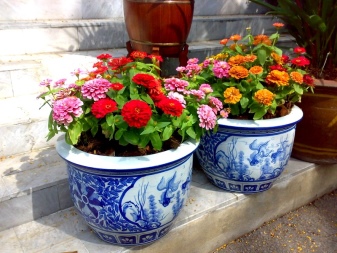
Zinnias growing in a flower bed with other horticultural crops usually behave very peacefully and do not tend to drown out the growth of other plants. These flowers go well with crops such as marigolds, chamomile, calendula, saffron or asters.


For more information on growing and caring for zinnia, see the next video.



































































































The comment was sent successfully.